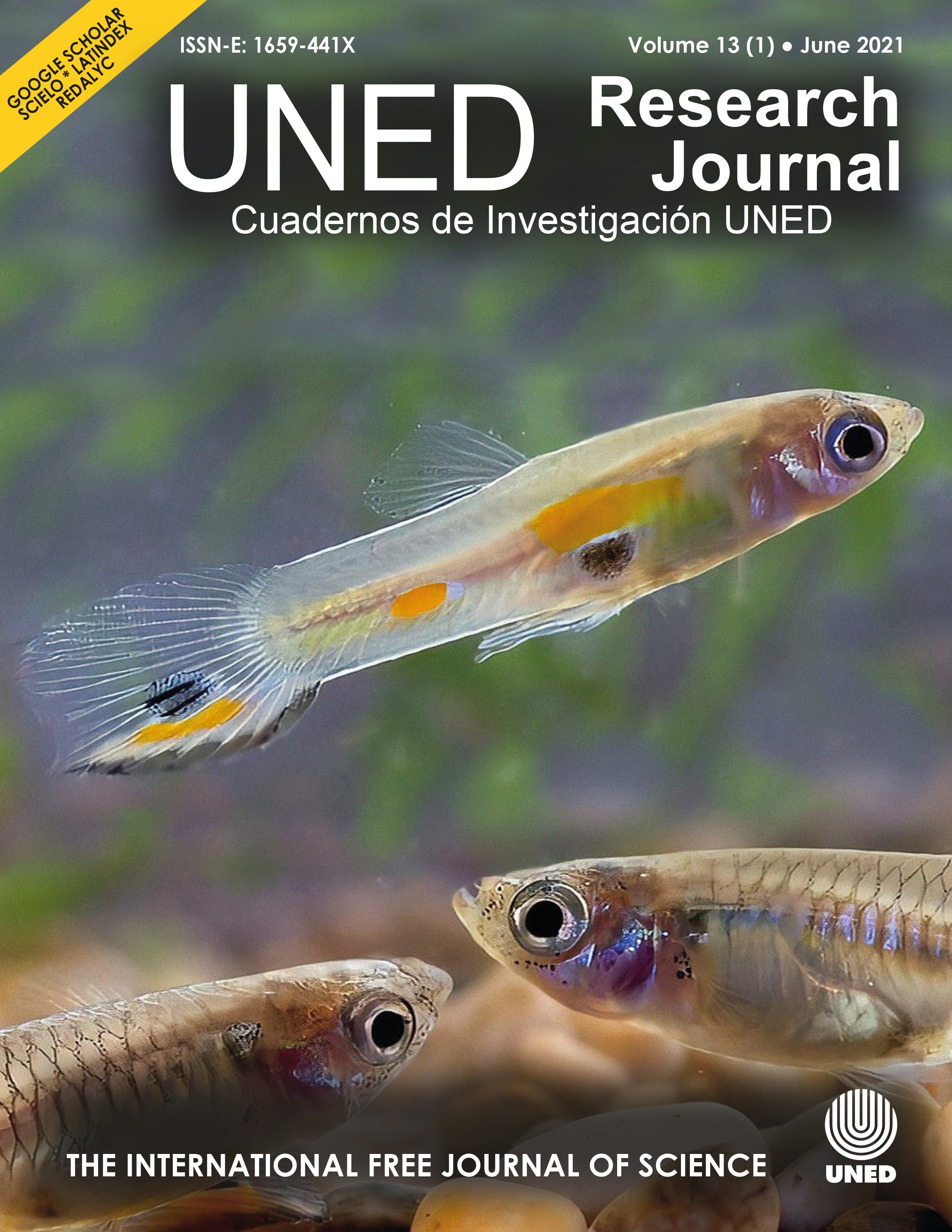Por qué los perezosos defecan en el suelo: rechazo del modelo mutualista
DOI:
https://doi.org/10.22458/urj.v13i1.3438Palabras clave:
Evolución del comportamiento de los perezosos, Selección natural y defecación, Algas, Mutualismo, Polillas, Evolución de mamíferos arbóreosResumen
Introducción: Varias hipótesis intentan explicar por qué los perezosos, siendo mamíferos arbóreos, defecan en el suelo, aumentando el riesgo de depredación. Objetivo: Revisar críticamente todas las hipótesis y proponer una nueva, compatible con todos los datos conocidos. Métodos: Verifiqué las bases e implicaciones de cinco hipótesis con la literatura disponible en febrero de 2021. Resultados: Las hipótesis anteriores carecen de datos confiables o son incompatibles datos publicados. Aquí propongo que la defecación en el suelo es un comportamiento ancestral que persiste en todas las especies de perezosos porque no ha habido suficiente presión selectiva en contra. Conclusiones: Lo que se sabe actualmente de la biología de los perezosos calza con la idea de que no ha habido suficiente presión selectiva para que los perezosos abandonen la defecación en el suelo.
Citas
Aiello, A. (1985). Sloth hair: unanswered questions. In G. G. Montgomery (ed). The Evolution of Armadillos, Sloths, and Vermilinguas (pp. 213-218). Washington, D.C., USA: Smithsonian Institution Press.
Bailey, T. N. (1974). Social organization in a bobcat population. The Journal of Wildlife Management, 38(3),435-446.
Chiarello A.G. (2008) Sloth ecology: an overview of field studies. In S. Vizcaíno & W. Loughry (eds.). The biology of the Xenarthra (pp. 269–280). Gainesville, FL: University Press of Florida.
Clauss, M. (2004). The potential interplay of posture, digestive anatomy, density of ingesta and gravity in mammalian herbivores: Why sloths do not rest upside down. Mammal Review, 34(3), 241-245.
Dünner, C., & Pastor, G. (2017). Manual de manejo, medicina y rehabilitación de perezosos. Chile: Fundación Huálamo.
Hayssen, V. (2009). Bradypus tridactylus (Pilosa: Bradypodidae). Mammalian Species, 839, 1-9. DOI: 10.1644/839.1
Hayssen, V. (2011). Choloepus hoffmanni (Pilosa: Megalonychidae). Mammalian Species, 43(873), 37-55. DOI: 10.1644/873.1
Hunt, A. P., & Lucas, S. G. (2018). The Record of Sloth Coprolites in North and South America: Implications for Terminal Pleistocene Extinctions. New Mexico Museum of Natural History and Science Bulletin, 79, 277-298.
Liberg, O. (1980). Spacing patterns in a population of rural free roaming domestic cats. Oikos, 32(3),336-349.
Montgomery, G. G., & Sunquist, M. E. (1975). Impact of Sloths on Neotropical Forest Energy Flow and Nutrient Cycling. Ecological Studies, 69–98. DOI:10.1007/978-3-642-88533-4_7
Pauli, J. N., Mendoza, J. E., Steffan, S. A., Carey, C. C., Weimer, P. J., & Peery, M. Z. (2014). A syndrome of mutualism reinforces the lifestyle of a sloth. Proceedings of the Royal Society B: Biological Sciences, 281(1778), 20133006. DOI: 10.1098/rspb.2013.3006
Peery, M. Z., & Pauli, J. N. (2014). Shade‐grown cacao supports a self‐sustaining population of two‐toed but not three‐toed sloths. Journal of Applied Ecology, 51(1), 162-170. DOI: 10.1111/1365-2664.12182
Ramírez, O., Vaughan, C., Herrera, G., & Guries, R. (2011). Temporal and spatial resource use by female three-toed sloths and their young in an agricultural landscape in Costa Rica. Revista de Biologia Tropical, 59(4), 1743-1755.
Slater, G. J., Cui, P., Forasiepi, A. M., Lenz, D., Tsangaras, K., Voirin, B., ... & Greenwood, A. D. (2016). Evolutionary relationships among extinct and extant sloths: the evidence of mitogenomes and retroviruses. Genome Biology and Evolution, 8(3), 607-621. DOI: 10.1093/gbe/evw023
Sunquist, M. E., & Montgomery, G. G. (1973). Activity patterns and rates of movement of two-toed and three-toed sloths (Choloepus hoffmanni and Bradypus infuscatus). Journal of Mammalogy, 54(4), 946-954. DOI: 10.2307/1379088
Suutari, M., Majaneva, M., Fewer, D. P., Voirin, B., Aiello, A., Friedl, T., ... & Blomster, J. (2010). Molecular evidence for a diverse green algal community growing in the hair of sloths and a specific association with Trichophilus welckeri (Chlorophyta, Ulvophyceae). BMC Evolutionary Biology, 10(1), 1-12. DOI: 10.1186/1471-2148-10-86
Vaughan, C., Ramírez, O., Herrera, G., & Guries, R. (2007). Spatial ecology and conservation of two sloth species in a cacao landscape in Limón, Costa Rica. Biodiversity and Conservation, 16(8), 2293-2310. DOI: 10.1007/s10531-007-9191-5
Voirin, B., Kays, R., Wikelski, M., & Lowman, M. (2013). Why Do Sloths Poop on the Ground? In M. Lowman, S. Devy, & T. Ganesh (eds). Treetops at Risk (pp. 195-199). Springer, New York, NY.
Waage, J. K., & Best, C. (1985). Arthropod associates of sloths. In G. G. Montgomery (ed). The Evolution of Armadillos, Sloths, and Vermilinguas (pp. 297-311). Washington, D.C., USA: Smithsonian Institution Press.
Descargas
Publicado
Cómo citar
Número
Sección
Licencia
Nota: Este resumen contiene un copyright incorrecto debido a problemas técnicos. Los autores que publican en esta revista aceptan los siguientes términos: Los autores conservan los derechos de autor y otorgan a la revista el derecho de primera publicación, con la obra simultáneamente bajo una Licencia de Atribución de Creative Commons que permite a otros compartir la obra con el reconocimiento de la autoría y la publicación inicial en esta revista.
Los contenidos se pueden reproducir citando la fuente según la licencia de Acceso Abierto CC BY 4.0. El almacenamiento automático en repositorios está permitido para todas las versiones. Incentivamos a los autores a publicar los datos originales y bitácoras en repositorios públicos, y a incluir los enlaces en todos los borradores para que los revisores y lectores puedan consultarlos en cualquier momento.
La revista está financiada con fondos públicos a través de la Universidad Estatal a Distancia. La independencia editorial y el cumplimiento ético están garantizados por la Comisión de Editores y Directores de Revistas de la UNED. No publicamos pautas publicitarias pagadas ni recibimos financiamiento de la empresa privada.
